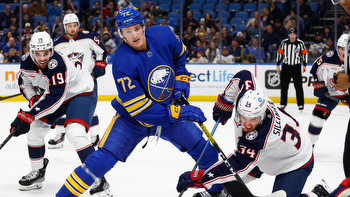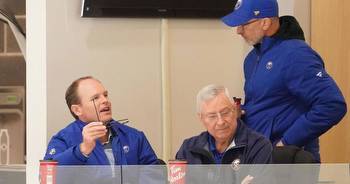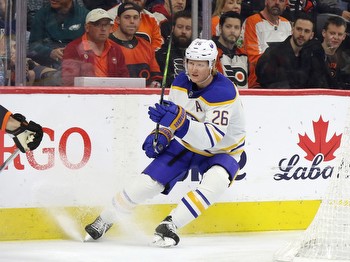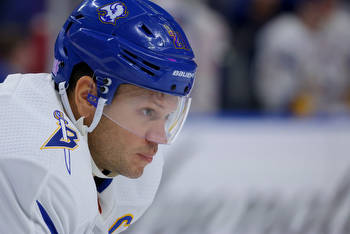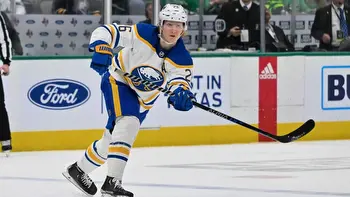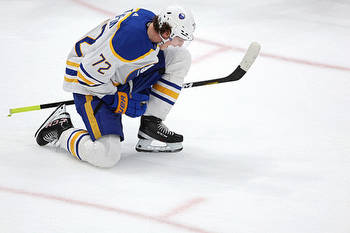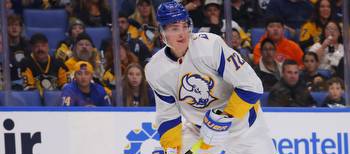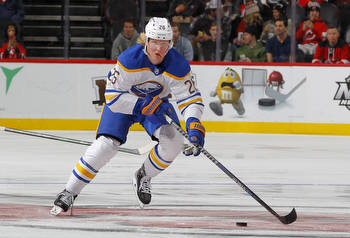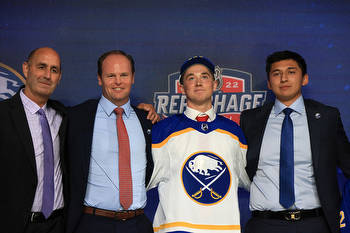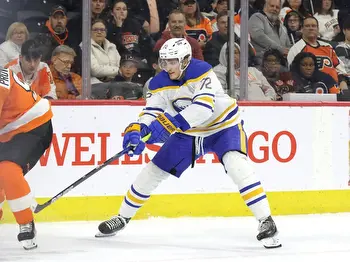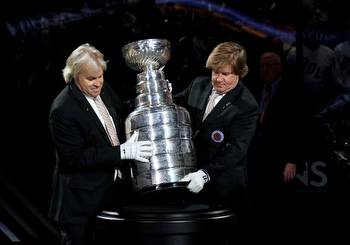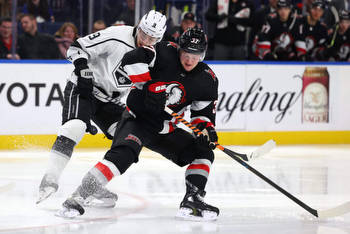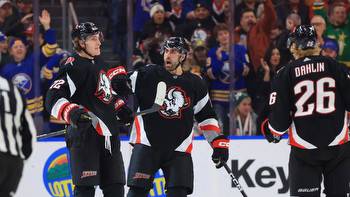Rasmus Dahlin's contract helps Sabres prepare for future
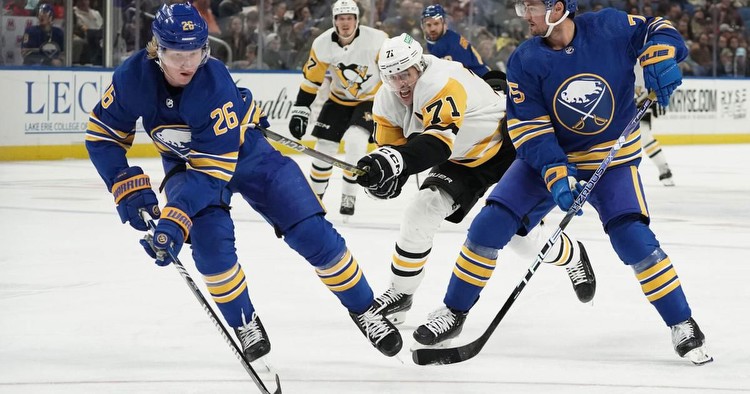
A contract negotiation that required numerous phone conversations and multiple in-person meetings across several months culminated Saturday, with Buffalo Sabres general manager Kevyn Adams calling his star defenseman to celebrate the latest step in a long-term plan that finally has the Sabres ready to contend this season and beyond.
“Just relief, pretty much,” said Rasmus Dahlin, recalling the emotional conversation after he learned that he can call Buffalo home for at least nine more seasons. “I was so happy. I barely remember what I said. It was like a blackout moment for me, I would say. I was just thankful.”
The 23-year-old leader of the Sabres’ defense signed an eight-year, $88 million contract extension that ensures he’s tied to Buffalo through the 2031-32 season.
The richest contract in the 53-year history of the Sabres is done. Dahlin, one of the best young defensemen in the NHL at only 23 years old, signed an eight-year, $88 million contract that carries the second-highest annual cap hit of anyone at his position. It is the richest contract in franchise history, surpassing the eight-year, $80 million pact signed by former captain Jack Eichel in 2017, and ensures that another key, young player is tied to Buffalo through the 2031-32 season.
Dahlin repeated to reporters Monday in KeyBank Center that he never doubted it would get done. He told his agents, Don Meehan and Craig Oster, “I don’t want to be anywhere else but Buffalo.” The contract begins next season, doesn’t expire until he is 32 years old and includes a no-move clause that will prevent the Sabres from trading Dahlin without his permission. Erik Karlsson of the Pittsburgh Penguins is the only NHL defenseman with a higher cap hit ($11.5 million), and Dahlin’s salary will spike in two years when he’ll be paid $12 million for the 2025-26 season.
Angst and stress were replaced by joy and relief for Adams when the negotiations came to a successful conclusion. Dahlin, a two-time All-Star, became the fourth Sabres player in less than 12 months to commit to Buffalo long-term, joining centers Tage Thompson and Dylan Cozens, and Dahlin’s primary defense partner last season, Mattias Samuelsson.
“Communication is regular, but then the phone call Saturday night that I had with Rasmus was pretty special,” Adams told reporters Monday. “And it’s one of the things that is incredibly rewarding about this job, when you can hear it in the player’s voice and the feeling you get when that happens is hard to kind of sum up, but it’s pretty special. I think part of the reason it’s so special to me is because I believe in these guys so much.”
This is the latest step in Adams’ long-term plan to build around a group of young players who want to win in Buffalo and proved through their actions every day since he became general manager in 2020 that they have the competitiveness and work ethic to be franchise pillars for a successful NHL team.
The Sabres aren’t stopping with Dahlin, either. Adams is still negotiating with Owen Power’s agent, Pat Brisson, to try to sign the 2021 first overall pick to a long-term contract. By completing Dahlin’s deal, Adams and his staff can project their available salary-cap space for the next several seasons.
NHL commissioner Gary Bettman told reporters at a recent Board of Governors meeting in New York that the league’s “very, very preliminary projection” is a salary-cap ceiling between $87 million and $88 million for 2024-25, which is approximately $4 million higher than this season. The Collective Bargaining Agreement limits how much it can rise each year, so it is possible for Sabres assistant general manager Mark Jakubowski to provide Adams with tentative figures that will be helpful as the team prioritizes which players to re-sign and how those contracts could impact their ability to add upgrades through trades or free agency.
The Sabres have approximately $33.375 million in cap space for 2024-25, according to the industry-leading website, CapFriendly.com, and, in addition to Power, they have a few notable restricted free agents that may be due for pay raises after this season: Casey Mittelstadt, Peyton Krebs and Henri Jokiharju.
Nowadays, teams want to sign their top young players for as long as possible. One recent example will impact the Sabres more than others.
Ottawa Senators defenseman Jake Sanderson, who, along with Power, was a candidate for the Calder Trophy as rookie of the year last season, received an eight-year, $64.4 million contract last month, despite having only 77 games of NHL experience. Power is two years younger and possesses immense offensive upside compared to Sanderson, so Adams and his staff are likely preparing for that contract to cost as much as $9 million per year.
Power, 20, finished second in voting for the Calder Trophy after a remarkable season in which led all rookies in average ice time per game (23:48). His 20:44 of even-strength ice time per game is the most by any rookie since the league began tracking the stat in 1997-98. His spot on the second power-play unit should help him produce more than the 32 points he had last season.
Players across the league are betting on themselves by taking short-term contracts with a higher annual cap hit because the salary-cap is expected to rise. Auston Matthews, for example, elected for a four-year pact this summer that’s worth $54 million. Dahlin could have done the same, but his deal with the Sabres is a strategic advantage that will allow Adams to plot their future without having to worry about signing Dahlin again in a few years.
“It’s really important because you’re putting a puzzle together,” Adams explained. “You’re looking at, when we do this, we obviously look at one, two, three years, but we’re also projecting out past that and we have to. Nobody knows exactly where the salary cap is going to go, although most agents think it will just keep going up, but nobody knows.
“The more certainty you have of where your salaries are structured and how you’re building your team gives you more opportunity to either add from the outside, where it’s making a trade or signing a UFA, or internally, your own guys. If you’re not dealing with all the information, it can make it more challenging. For Rasmus to make the commitment to us and for us to make the commitment to him for eight years, especially when you’re starting to see more elite players do shorter deals, really helps us in terms of our planning.”
Dahlin quickly became a priority last season when he continued his transformation from a raw prospect with elite offensive ability into a top, well-rounded NHL defenseman. He produced career-highs in goals (15), assists (58) and points (73), while averaging more ice time per game (25:48) than all but two defensemen in the league. Dahlin continued his development as a leader on and off the ice, and he finished sixth in voting for the Norris Trophy, which no defenseman in Sabres history has one. He’s determined to be more consistent in every area of his game after a season in which he was a driving force behind an offense that scored the third-most goals in the league.
The Sabres will eventually have trouble paying everyone. It is one of the harsh realities of the salary-cap era. Championship-caliber teams are challenged each summer when their players approach unrestricted free agency. Difficult decisions are made. It is why Adams and Sabres head coach Don Granato have stressed the importance of patience. The Sabres will need to successfully develop their numerous high-end prospects into impactful NHLers because the team will need more players on entry-level contracts as the core becomes expensive. There are numerous examples that show how a short-term strategy can undo years of smart scouting, most notably Ottawa, which is currently in a contract dispute with one of its top young players, Shane Pinto. It is why Adams wouldn’t unload prospects and draft picks for pricy veterans like defenseman Jakub Chychrun.
Devon Levi can be signed to a contract extension as soon as this summer if the Sabres determine he is ready for that kind of commitment. He is a restricted free agent in the summer of 2025, along with Jack Quinn and JJ Peterka. Adams must also prepare to sign Alex Tuch, whose value has skyrocketed since he arrived in Buffalo. The seven-year, $33.5 million contract Tuch signed with Vegas in October 2018 has become one of the best bargains in the league.
Last season, Tuch produced career highs in goals (36), assists (43) and points (79). He has been a catalyst for positive change on and off the ice since arriving in the Eichel trade, and he’ll be due a significant raise if he performs as expected until he is scheduled to reach unrestricted free agency in the summer of 2026.
A three-goalie depth chart shouldn’t last long. General Manager Kevyn Adams will eventually need the roster spot for a forward or defenseman, and the schedule should allow Devon Levi to start the bulk of Buffalo’s games in October.
Terry and Kim Pegula, the Sabres’ owners, have trusted in Adams’ long-term plan that required franchise-altering trades with an emphasis on drafting and developing talent to surround his core, and Adams has moved swiftly to sign players such as like Dahlin when it is clear that each will only improve while the franchise takes steps toward its goal of winning the Cup.
“You cannot do what we’ve done in the last couple of years (without a commitment from ownership and management), and a big part of it is being patient,” Granato said. “You can be patient, but you also have to be persistent, and Kevyn, I think, has been very persistent in the type of people we want here. There’s lots of talented hockey players around the world, but we want to get the right people, and Kevyn and our entire staff have been very persistent. … To have this player, in Rasmus, to clearly state I want to be here long-term – the market is the market; He’s in the market. You can do that anywhere. But he says, ‘I want to be right here.’ That’s pretty nice.”

